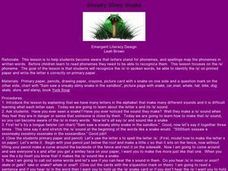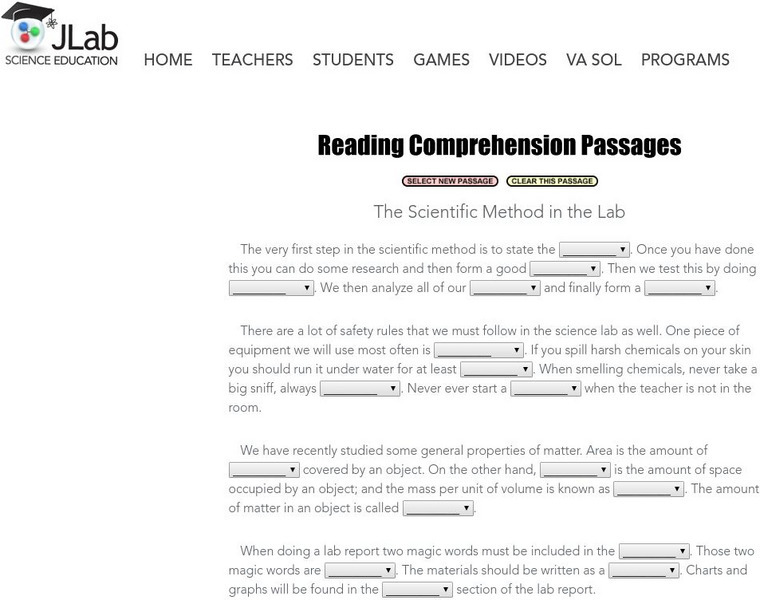Curated OER
Comparing Forecasts To Today's Weather
First graders compare forecasts to today's weather. They gather information about today's weather and record it on a chart. Students record information on the weather and discuss the importance of forecasts.
Curated OER
Curious About Creepy Crawlies?
Students create oral presentations and visual aids to assist their inquiry about various insects. They reflect on the importance of learning about insects while working in small groups.
Curated OER
Scoping Out Space
Students research existing and proposed telescope projects and synthesize their knowledge by creating presentations on each telescope and speculating about which project is worthy of additional funding.
Curated OER
Suddenly!
Third graders explore the text "Suddenly." They create a new version of the story using the predictable patterns from the original story. Students share their stories with the rest of the class.
Curated OER
The Fear of Exploration Because of... Sea Monsters
Eighth graders examine the underestimated cause as to why exploration into the western hemisphere was not common before the 1400's. They reconstruct the causes/effects of exploration to North America.
Curated OER
Science: Quick Freeze
Learners observe an experiment of freezing point depression using club soda. Through observation, they note that the carbon dioxide molecules disrupt the capacity of the water molecules to solidify. Precautions must be taken to assure...
Curated OER
Ehhh?? I Can't Hear You!
Students identify the /e/ sound in spoken words in this lesson. They say a tongue twister with words emphasizing the short /e/ sound. They then listen to the story "Peg the Hen" and do an "I Can't Hear You" motion whenever they hear...
Curated OER
Tick Tock Goes The Clock
Young scholars practice letter recognition in written language and sounds for /t/ in both the upper and lower case forms. They utilize a chart with "Today Teddy talked to ten people at two o'clock," on it while making the sounds that are...
Curated OER
Buh, Buh, Buh B!!
Students complete a variety of activities related to the letter "B." As a class they recite a tongue twister, then trace and write the letter "B." Students identify the words in the poem that contain the /b/ sound and draw a picture of...
Curated OER
Elephants Enjoy Eating Eggs
Students recognize the short vowel e in written and spoken language. Through listening and matching activities, they discriminate the vowel sound /e/ from other phonemes. Students practice using the phoneme and letter in words by writing...
Curated OER
Sneaky Slimy Snake
Students complete a variety of activities related to the /s/ phoneme. As a class they recite a tongue twister, then trace and write the letter S. Students then listen to word pairs and identify the word in each pair containing the /s/...
Curated OER
Launching Rockets
Second graders discuss experiences of watching a rocket launch either on television or in person before making paper rockets. They make and color rockets which they attempt to launch using a strong breath blown through a straw at the...
Curated OER
"Mmmm... Yummy to My Tummy!"
Students answer a series of question about different letter sounds. They verbally practice the sounds of each letter following set responses. They write the different letters and find words that start with that letter.
Curated OER
Color in Everyday Life
Students are introduced to color theory. Before beginning their color unit, they watch an informational video covering the use of color in everyday life. Students complete a listening guide worksheet and discuss their views of the...
Curated OER
Which Colors Absorb the Most Energy?
Students measure the temperatures over time of different colored envelopes in order to explore the different rates at which each color absorbs energy from a heat lamp. They record their data and graph their results.
Curated OER
How a Circuit Works
Students discover the basic principles of circuits by designing and testing some of their own. They are told that circuits usually have a power source such as a battery and a resistor such as a light. Students make a circuit using a...
Curated OER
The Effects of Color on Heat Absorption And Climate
Young scholars conduct an experiment to determine the effects of soil color on its day and night time temperatures. In small groups, they prepare dishes of black soil, brown peat moss, and white sand. They record the temperature changes...
Curated OER
Out of the Fire
Students share ideas about a lead for a breaking news story regarding the California wildfires. They brainstorm angles for a series of news items and write analysis papers that address the tone and content of a piece published in The New...
Curated OER
The Thin Red Line
Students explore various aspects of the subprime mortgage crisis. Through research and interviews, students, working in groups, research how race played a role in the subprime mortgage crisis and how it has affected their local community.
Curated OER
From Object To Story
Students engage in a study that focuses upon the study of artifacts for the purpose of defining the heritage of family. They conduct research using a variety of resources. The information is used in order to create a personal family...
Curated OER
And The Winner Is
Students investigate the concept of The MTV Awards shows and how they have been used to form the culture of a generation over time. They view rerun episodes of the shows and write reflectively about observations that are made.
Curated OER
Who Stole My Salad?
Eighth graders explain how protein is made in the cell. In this biology lesson, 8th graders translate RNA and DNA using an internet database. They determine the thief based on evidence collected.
Curated OER
Food Pyramid Nutrition Puzzles
Students put together food group puzzles on the computer and identify the healthy message in the end. In this food lesson plan, students identify the food group that the puzzle is representing as well.
Thomas Jefferson National Accelerator Facility
Jefferson Lab: Reading Passages: The New Scientific Method in the Lab
Read and fill in the blanks of this passage explaining the new scientific method procedure in the lab. Each blank has a dropdown menu with choices. When you finish, click CHECK MY ANSWERS. If you pick a wrong answer, the right answer...

























